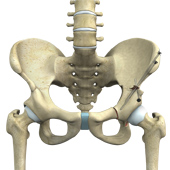
What are the Benefits?
The primary benefits are pain relief from impingement symptoms through an arthroscopic procedure. There is evidence to support that hip impingement leads to osteoarthritis over time through repetitive "bumping of the femoral neck on the hip socket, leading to articular cartilage damage. Although prevention of long term arthritic changes with hip impingement surgery are unproven at this point, it is still the current thinking that arthroscopy can eliminate impingement, reduce articular cartilage damage, and therefore reduce the risk of future arthritis in patients. - hence the term "hip preservation".
Who could have this surgery?
Anyone healthy enough for surgery with appropriate symptoms is a potential candidate for the surgery. Age is not a contra-indication per se, but with increasing age comes increased chances of concomitant arthritic change, which will reduce symptomatic improvement from the surgery. The best candidates are people with recalcitrant hip pain or "groin pain" who have failed nonoperative treatments such as rest, physical therapy, ant-inflammatory medications, activity modification, and corticosteroid injections and who DO NOT have significant arthritic changes on imaging.
What are the symptoms of someone suffering rom hip pain?
Typically anterior hip pain or groin pain exacerbated by activity, walking, sitting.
What are the causes or reasons behind getting hip arthroscopy?
Hip impingement frequently leads to tears of a hip cartilage called the acetabular labrum. Once a labral tear occurs, hip pain will frequently increase. As the femur and hip socket bones "bump" or "impinge", the torn labral cartilage is pinched in between and pain occurs. The main goals of the surgery are to repair the torn labral cartilage and resect some of the impinging boney prominences that lead to pain and labral tearing.
What does the surgery entail?
THE SURGERY IS OUTPATIENT and is arthroscopic, meaning a small camera system is used through small incisions to do the surgery in the hip joint. The bone may be resected appropriately and the labral tear repaired with advanced arthroscopic instrumentation, all while watching ona video monitor in the operating room.
What is the typical recovery time?
The recovery time varies from person to person but averages from 6 - 12 months. much of the pre-operative pain will be alleviated in the first 3 months but patients may improve for even 1-2 years after surgery. Average return to sports and exercise is around 6 months although more minor forms of exercise may be started much sooner.
Is it better or different than hip replacement? If so, how?
Hip replacements are for osteoarthritis - hip arthroscopy is for hip pain related to impingement and other non-arthritic conditions. If a significant amount of arthritis is present, hip arthroscopy is only helpful in a very select few cases but generally is not recommended. Just because one is older does not necessarily mean the hip is arthritic and the only solution is hip replacement. Many people never develop hip arthritis and each patient should have x-rays and occasionally other advanced imaging to determine the best treatment.
You will need the Adobe Reader to view and print these documents. 
